Global Market Comments
August 30, 2021
Fiat Lux
Featured Trade:
(MARKET OUTLOOK FOR THE WEEK AHEAD,
or THE HIGHER WE GO THE CHEAPER WE GET),
(JPM), (BAC), (C), (GS), (MS), (BLK), (FCX), (X),
(WYNN), (MGM), (ALK), (LUV), (HAL), (SLB), (TLT)

Global Market Comments
August 30, 2021
Fiat Lux
Featured Trade:
(MARKET OUTLOOK FOR THE WEEK AHEAD,
or THE HIGHER WE GO THE CHEAPER WE GET),
(JPM), (BAC), (C), (GS), (MS), (BLK), (FCX), (X),
(WYNN), (MGM), (ALK), (LUV), (HAL), (SLB), (TLT)

I am sitting here holed up in my office in San Francisco.
Lake Tahoe is being evacuated as the Caldor fire is only ten miles away and the winds are blowing towards it. The visibility there is no more than 500 yards. The ski resorts are pointing their snow cannons towards their buildings to ward off flames.
Conditions are not much better here in Fog City. We are under a “stay at home” order due to intense smoke and heat. Even here, the fire engines are patrolling by once an hour.
The Boy Scout trip got cancelled this weekend, so the girls are having a cooking competition, chocolate chip waffles versus a German chocolate cake.
To make matters worse, I have been typing with only one finger all week, thanks to the elbow surgery I had on Tuesday. Next time, I’ll think twice before taking down a 300-pound steer. When I told the doctor how I incurred this injury, he laughed. “At your age?”
Which leaves me to contemplate this squirrelly stock market of ours. I have always been a numbers guy. But the higher the indexes rise, the cheaper stocks get. That’s not supposed to happen, but that is the fact.
We started out 2021 with an S&P 500 price earnings multiple of 25X. Now, we are down to a lowly 21X and the (SPY) is 20% higher, rising from $360 to $450.25.
The analyst community, ever the lagging indicator that they are, had S&P forward earnings for 2022 all the way down to $175. They have been steadily climbing ever since and are now touching $200 a share.
This is what 20/20 hindsight gets you. That and $5 will get you a cup of coffee at Starbucks. It takes a madman like me to go out on a limb with high numbers and then be right.
So what follows an ever-cheaper market? A more expensive one. That means stocks will continue to my set-in-stone target of $475 for the (SPY) for yearend, and (SPY) earnings of over $200 per share.
It gets better.
(SPY) earnings should hit $300 a share by 2025 and $1,400 a share by 2030. That makes possible my (SPY) target of $1,800 and my Dow Average target of 240,000 in a decade.
What are markets getting right that analysts and bears are getting wrong?
The future has arrived.
The pandemic brought forward business models and profitability by a decade. Technology is hyper-accelerating on all fronts.
Cycles are temporary but adoption is permanent. We are never going back to the old pre-pandemic economy. As a result, stocks are now worth a lot more than they were only two years ago.
So what do we buy now? There is a second reopening trade at hand, the post-delta kind. That means buying banks (JPM), (BAC), (C), brokers (GS), (MS), money managers (BLK), commodities (FCX), (X), hotels (WYNN), (MGM), airlines (ALK), (LUV), and energy (HAL), (SLB).
And what do we avoid like the plague? Bonds (TLT), which offer only confiscatory yields in the face of rising inflation with gigantic negative interest rates.
As for technology stocks, they will go sideways to up small in the aftermath of their ballistic moves of the past three months.
You all know that I am a history buff and there are particular periods of history that are starting to disturb me.
In August, we saw ten new intraday highs for the S&P 500 (SPY). That has not happened since 1987. Remember what happened in 1987?
We have not seen 11 new highs in August since 1929. The only negative three months seen since 1929 are August, September, and October. Remember what happened in 1929?
If that doesn’t scare the living daylights out of you, then nothing will. So, it seems we are in for some kind of correction, even if it’s just the 5% kind.
As for me, I’m looking forward to 2030.
The “Everything” Rally is on, according to my friend, Strategas founder Tom Lee. You can see it in the recent strength of epicenter stocks like energy, hotels, airlines, and casinos. It could run into 2022.
The Taper is this year and interest rate rises are later, said Jay Powell at Jackson Hole last week. Markets will be jumpy, especially bonds. Fed governor Jay Powell’s every word was parsed for meaning. Dove all the way. The larger focus will be on the August Nonfarm Payroll report out this week.
Pfizer Covid vaccination gets full FDA approval, requiring millions more to get shots and bringing forward the end of the pandemic. All 5 million government employees will now get vaccinated, including the entire military. It’s the fastest drug approval in history. Some 37,000 new cases in one day. The stock market likes it. Take profits on (PFE)
Bitcoin tops $50,000 after breaking several key technical levels to the upside. Next stop is a double top at $66,000. It helps that Coinbase is buying $500 million worth of crypto for its own portfolio. Buy (COIN) on dips.
The US Dollar will crash in coming years, says Jeffry Gundlach and I think he is right. Emerging markets will become the next big play but not quite yet. Gold (GLD) will be a great hideout once it comes out of hibernation. China will soon return to outperforming the US. The dollars reserve currency status is at risk.
The lumber crash is saving $40,000 per home, says Toll Brothers (TOL) CEO, Doug Yearly. Last year, lumber prices surged from $300 per board foot to an insane $1,700, thanks to a Trump trade war with Canada and soaring demand. It all flows straight through the bottom line of the homebuilders which should rally from here. Buy (TOL) on dips.
China’s crackdown creates investment opportunities, says emerging investing legend Mark Mobius. He sees corporate governance improving over the long term. The gems are to be found among smaller companies not affected by Beijing’s hard-line. Mobius loves India too.
My Ten-Year View
When we come out the other side of pandemic, we will be perfectly poised to launch into my new American Golden Age, or the next Roaring Twenties. With interest rates still at zero, oil cheap, there will be no reason not to. The Dow Average will rise by 800% to 240,000 or more in the coming decade. The American coming out the other side of the pandemic will be far more efficient and profitable than the old. Dow 240,000 here we come!
My Mad Hedge Global Trading Dispatch saw a healthy +7.62% gain in August. My 2021 year-to-date performance appreciated to 76.83%. The Dow Average was up 15.87% so far in 2021.
That leaves me 80% in cash at 20% in short (TLT) and long (SPY). I’m keeping positions small as long as we are at extreme overbought conditions.
That brings my 12-year total return to 499.38%, some 2.00 times the S&P 500 (SPX) over the same period. My 12-year average annualized return now stands at an unbelievable 42.80%, easily the highest in the industry.
My trailing one-year return popped back to positively eye-popping 116.67%. I truly have to pinch myself when I see numbers like this. I bet many of you are making the biggest money of your long lives.
We need to keep an eye on the number of US Coronavirus cases at 39 million and rising quickly and deaths topping 638,000, which you can find here.
The coming week will bring our monthly blockbuster jobs reports on the data front.
On Monday, August 30 at 11:00 AM, Pending Home Sales are published. Zoom (ZM) reports.
On Tuesday, August 31, at 10:00 AM, S&P Case Shiller National Home Price Index for June is released. CrowdStrike (CRWD) reports.
On Wednesday, September 1 at 10:45 AM, the ADP Private Employment report is disclosed.
On Thursday, September 2 at 8:30 AM, Weekly Jobless Claims are announced. DocuSign (DOCU) reports.
On Friday, September 3 at 8:30 AM, the all-important August Nonfarm Payroll report is printed. At 2:00 PM, the Baker Hughes Oil Rig Count is disclosed.
Oh and the German chocolate cake won, but please don’t tell anyone.
As for me, given the losses in Afghanistan this week, I am reminded of my several attempts to get into this troubled country.
During the 1970s, Afghanistan was the place to go for hippies, adventurers, and world travelers, so of course, I made a beeline for straight for it.
It was the poorest country in the world, their only exports being heroin and the blue semiprecious stone lapis lazuli, and illegal export of lapis carried a death penalty.
Towns like Herat and Kandahar had colonies of westerners who spent their days high on hash and living life in the 14th century. The one cultural goal was to visit the giant 6th century stone Buddhas of Bamiyan 80 miles northwest of Kabul.
I made it as far as New Delhi in 1976 and was booked on the bus for Islamabad and Kabul ($25 one-way). Before I could leave, I was hit with amoebic dysentery.
Instead of Afghanistan, I flew to Sydney, Australia where I had friends and knew Medicare would take care of me for free. I spent two months in the Royal North Shore Hospital where I dropped 50 pounds, ending up at 125 pounds.
I tried to go to Afghanistan again in 2010 when I had a large number of followers of the Mad Hedge Fund Trader stationed there, thanks to the generous military high-speed broadband. The CIA waved me off, saying I wouldn’t last a day as I was such an obvious target.
So, alas, given the recent regime change, it looks like I’ll never make it to Afghanistan. I won’t live long enough to make it to the next regime change. It’s just one more concession I’ll have to make to my age. I’ll just have to content myself reading A One Thousand and One Nights at home instead. The Taliban blew up the stone Buddhas of Bamiyan in 2001.
In the meantime, I am on call for grief counseling for the Marine Corps for widows and survivors. Business has been thankfully slow for the last several years. But I’ll be staying close to the phone this weekend just in case.
Good luck and good trading.
John Thomas
CEO & Publisher
The Diary of a Mad Hedge Fund Trader

India in 1976
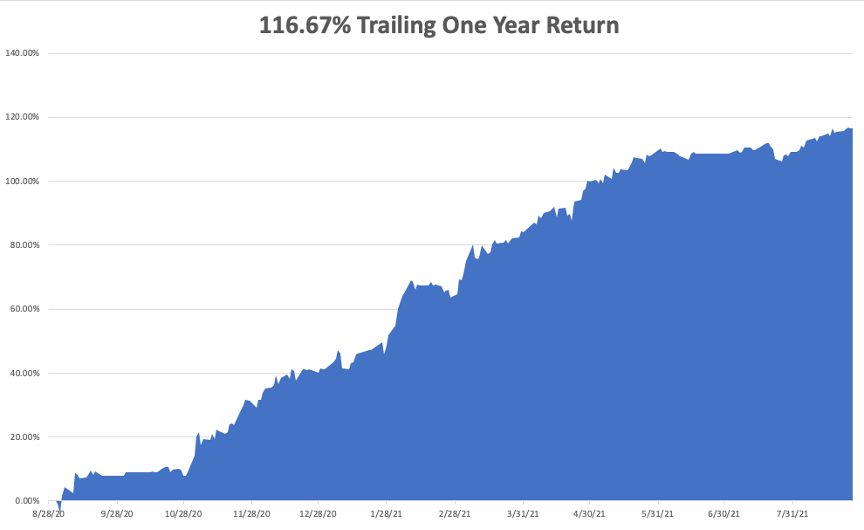
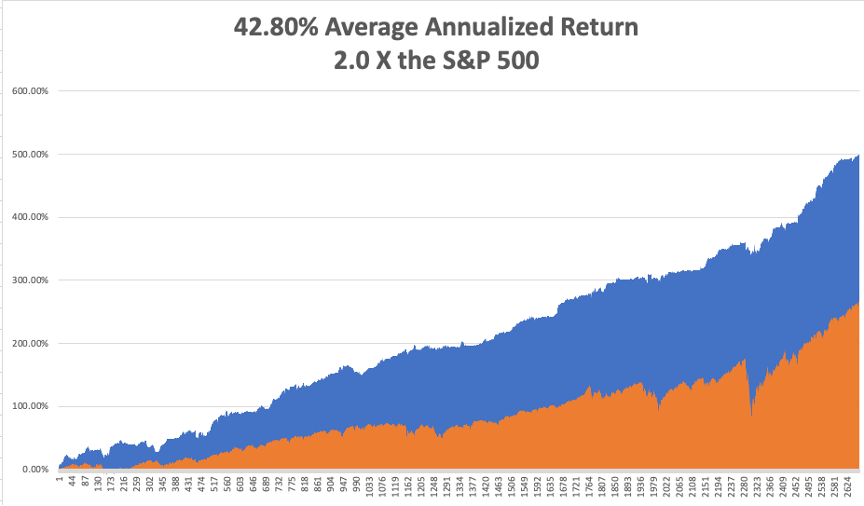
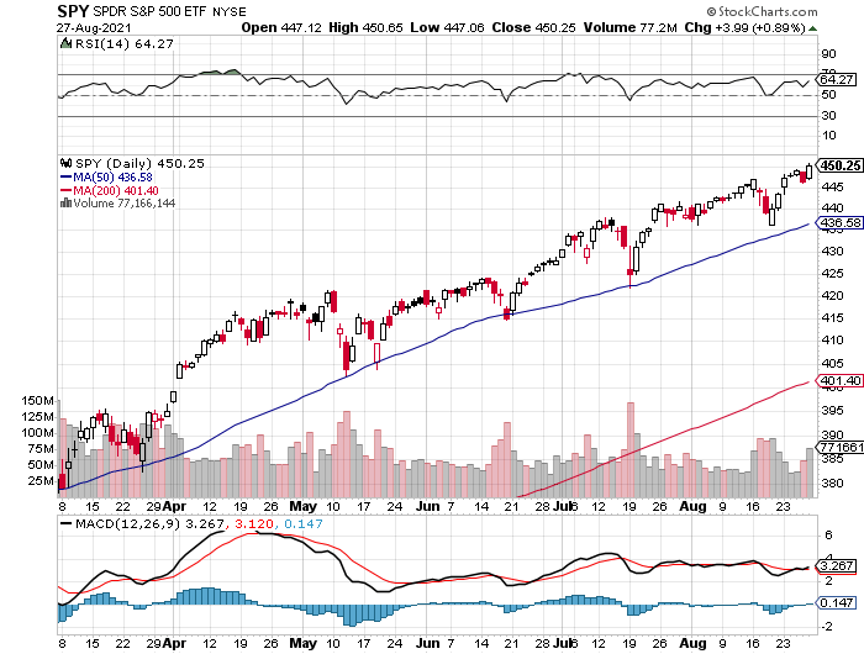
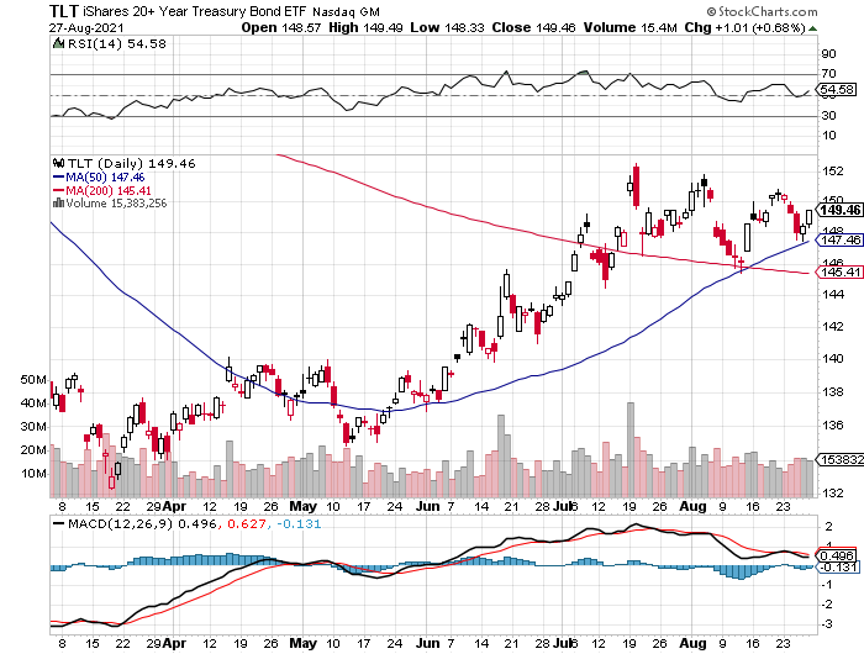
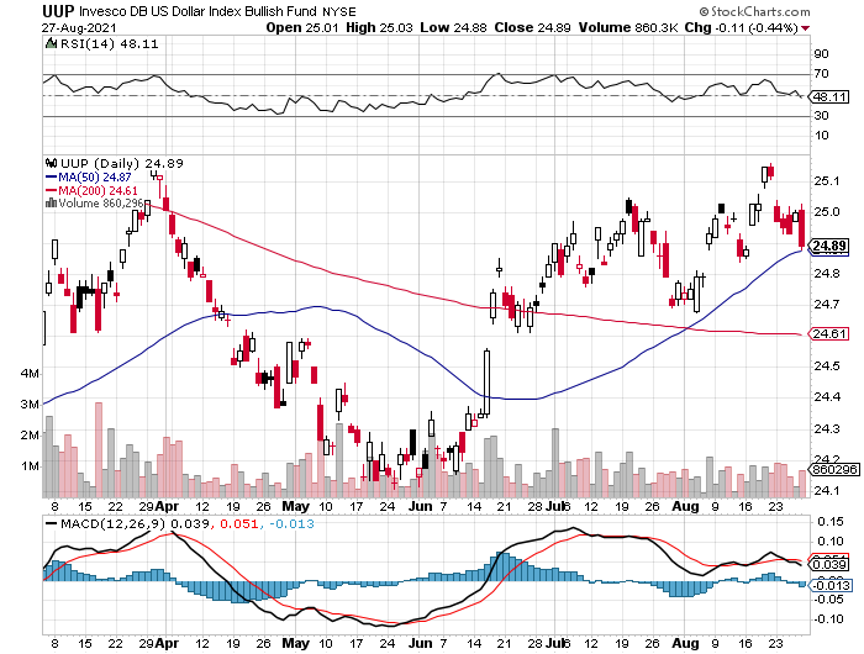
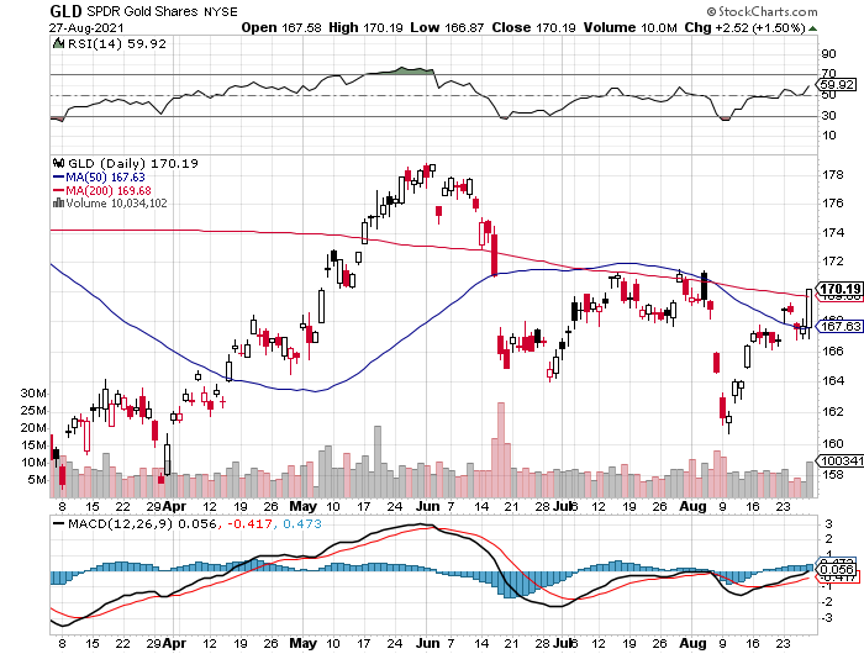
Global Market Comments
April 5, 2021
Fiat Lux
Featured Trade:
(MARKET OUTLOOK FOR THE WEEK AHEAD, or A SUPERCHARGED ECONOMY IS SUPERCHARGING THE STOCK MARKET),
(SPX), (LRCX), (AMAT), (VIX), (BA), (LUV), (AKL), (TSLA), (DAL)

Stocks have risen at an annualized rate of 40% so far in 2021. If that sounds too good to be true, it is.
But then, we have the greatest economic and monetary stimulus of all time rolling out also.
Of the $10 trillion in government spending that has or is about to be approved, virtually none of it has been spent. There hasn’t been enough time. It turns out that it is quite hard to spend a trillion dollars. Corporate America and its investors are salivating.
The best guess is that the new spending will create five million jobs for the economy over eight years, taking the headline Unemployment Rate down to a full employment 3-4%. The clever thing about the proposal is that it is financed over 15 years, which takes advantage of the current century's low interest rates.
That is something many strategists have been begging the US Treasury to do for years. Take the free money while it is on offer.
There is something Rooseveltean about all this, with great plans and huge amounts of money, like 10% of GDP on the table. But then we did just come out of a Great Depression, with unemployment peaking at 25 million, the same as in 1933.
The package is so complex that it is unlikely to pass by summer. Until then, stocks will probably continue to rally on the prospect.
It makes my own forecast of a 30% gain in stocks and a Dow Average of 40,000 for 2021 look overly cautious, conservative, and feeble (click here). But then, you have to trade the market you have, not the one you want.
And here is the really fun part. After a grinding seven-month-long correction, technology stocks have suddenly returned from the dead. All the best names gained 10% or more in the previous four-day holiday-shortened week. Clearly, investors have itchy trigger fingers with tech stocks at these levels.
In the meantime, technology stock prices have fallen 20-50% while earnings have jumped by 20% to 40%. What was expensive became cheap. It was a setup that was begging to happen.
This is great news because technology stocks are the core to all non-indexed retirement funds.
The S&P 500 (SPX) blasted through 4,000, a new all-time high, off the back of one of the largest infrastructure spends in history. Job creation over the next eight years is estimated at 5 million. Corporate earnings will go through the roof. Tech is back from the dead. Leaders were semiconductor equipment makers like my old favorites, Applied Materials (AMAT) and Lam Research (LRCX). The Volatility Index (VIX) sees the $17 handle, hinting at much higher to come. The next leg up for the Roaring Twenties has begun!
Biden Infrastructure Bill Tops $2.3 Trillion. Of course, some of it isn’t infrastructure but other laudable programs that starved under the Trump administration, like spending on seniors (I’m all for that!). Still, spending is spending, and this will turbocharge the economy all the way out to say….2024. The impact on interest rates will be minimal as long as the Fed keeps overnight rates near zero, as they have promised to do for nearly three years. Making the power grid carbon-free by 2035 is a goal and would require a 50% increase in solar national installations. Infrastructure spending is always a win-win because the new tax revenues it generates always pay for it in the end.
March Nonfarm Payroll Report exploded to the upside, adding a near record 917,000 jobs, and taking the headline Unemployment Rate down to 6.0%. Employers are front running Biden’s infrastructure plans, hiring essential workers while they are still available. Look for labor shortages by summer, especially in high paying tech. Leisure & Hospitality was the overwhelming leader at a staggering 280,000, followed by Government at 136,000 and Construction at 110,000.
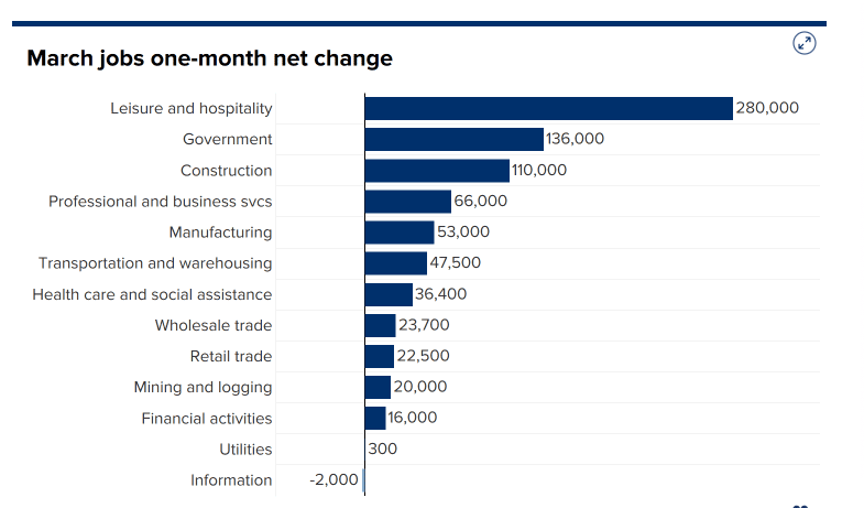
Goldilocks lives on, with a 1.0% drop in Consumer Spending in February, keeping inflation close to zero. The Midwest big freeze is to blame. You can’t buy anything when there’s no gas for the car and no electricity once you get there, as what happened in Texas. The $1,400 stimulus checks have yet to hit much of the country, although I got mine. It couldn’t be a better environment for owning stocks. Keep buying everything on dips.
Consumer Confidence soared, up 19.3 points to 109 in February, according to the Conference Board. It’s the second-biggest move on record. A doubling of the value of your home AND your stock portfolio in a year is making people feel positively ebullient. Oh, and free money from the government is in the mail.
The Suez Canal reopened, allowing 10% of international trade to resume. A massive salvage effort that freed the 200,000 ton Ever Given. The ship will be grounded for weeks pending multiple inspections. Somebody’s insurance rates are about to rachet up. It all shows how fragile is the international trading system. Deliveries to Europe will still be disrupted for months. It puts a new spotlight on the Arctic route from Asia to Europe, which is 4,000 nm shorter.
Boeing (BA) won a massive order, some 100 planes from Southwest Air (LUV), practically the only airline to use the pandemic to expand. Boeing can fill the order almost immediately from 2020 cancelled orders for the $50 million 737 MAX. Keep buying both (BA), (LUV), and (AKL) on dips.
Tesla blows away Q1 deliveries, with a 184,400 print, or 47.5% high than the 2021 rate. That is without any of the new Biden EV subsidies yet to kick in. Lower priced Model 3 sedans and Model Y SUVs accounted for virtually all of the report. The Shanghai factory is kicking in as a major supplier to high Chinese demand. The one million target for 2021 is within easy reach. Traders saw this coming (including me) and ramped the stock up $100. Buy (TSLA) on dips. My long-term target is $10,000.
United Airlines hires 300 pilots to front-run expected exposure summer travel. CEO Scott Kirby says domestic vacation travel has almost completely recovered. Keep buying (LUV), (AKL), and (DAL) on dips.
When we come out the other side of pandemic, we will be perfectly poised to launch into my new American Golden Age, or the next Roaring Twenties. With interest rates still at zero, oil cheap, there will be no reason not to. The Dow Average will rise by 400% to 120,000 or more in the coming decade. The American coming out the other side of the pandemic will be far more efficient and profitable than the old. Dow 120,000 here we come!
My Mad Hedge Global Trading Dispatch profit reached 0.38% gain during the first two days of April on the heels of a spectacular 20.60% profit in March.
I used the Monday low to double up my long in Tesla. After that, it was off to the races for all of tech. I caught a $100 move on the week.
My new large Tesla (TSLA) long expires in 9 trading days.
That leaves me with 50% cash and a barrel full of dry powder.
My 2021 year-to-date performance soared to 44.47%. The Dow Average is up 9.40% so far in 2021.
That brings my 11-year total return to 467.02%, some 2.08 times the S&P 500 (SPX) over the same period. My 11-year average annualized return now stands at an unbelievable 41.20%, the highest in the industry.
My trailing one-year return exploded to positively eye-popping 108.51%. I truly have to pinch myself when I see numbers like this. I bet many of you are making the biggest money of your long lives.
We need to keep an eye on the number of US Coronavirus cases at 30.6 million and deaths topping 555,000, which you can find here.
The coming week will be dull on the data front.
On Monday, April 5, at 10:00 AM, the ISM Non-Manufacturing Index for March is released.
On Tuesday, April 6, at 10:00 AM, US Consumer Inflation Expectations for March are published.
On Wednesday, April 7 at 2:00 PM, the minutes of the last Federal Open Market Committee Meeting are published.
On Thursday, April 8 at 8:30 AM, the Weekly Jobless Claims are printed.
On Friday, April 9 at 8:30 AM we get the Producer Price Index for March. At 2:00 PM, we learn the Baker-Hughes Rig Count.
As for me, I recently turned 69, so I used a nice day to climb up to the Lake Tahoe High Sierra rim at 9,000 feet, found a nice granite boulder sit on to keep dry, and tried to figure out what it was all about.
I’ve been very lucky.
I had a hell of a life that I wouldn’t trade for anything. I wouldn’t change a bit (well, maybe I would have bought more Apple shares at a split-adjusted 30 cents in 1998. I knew Steve was going to make it).
Since I’ve always loved what I did, journalist, trader, combat pilot, hedge fund manager, writer, I don’t think I have “worked” a day in my life.
I fought for things I believed in passionately and won, and kept on winning. It’s good to be on the right side of history.
I have loved and lost and loved again and lost again, and in the end outlived everyone, even my younger brother, who died of Covid-19 a year ago. The rule here is that it is always the other guy who dies. My legacy is five of the smartest kids you ever ran into. They’re great traders as well.
So I’ll call it a win.
I visited my orthopedic surgeon the other day to get a stem cell top-up for my knees and she asked how long I planned to keep coming back. I told her 30 years, and I meant it.
There’s nothing left for me to do but to make you all savvy in the markets and rich, something I leap out of bed every morning at 5:00 AM to accomplish.
Enjoy your weekend.
Stay healthy.
John Thomas
CEO & Publisher
The Diary of a Mad Hedge Fund Trader

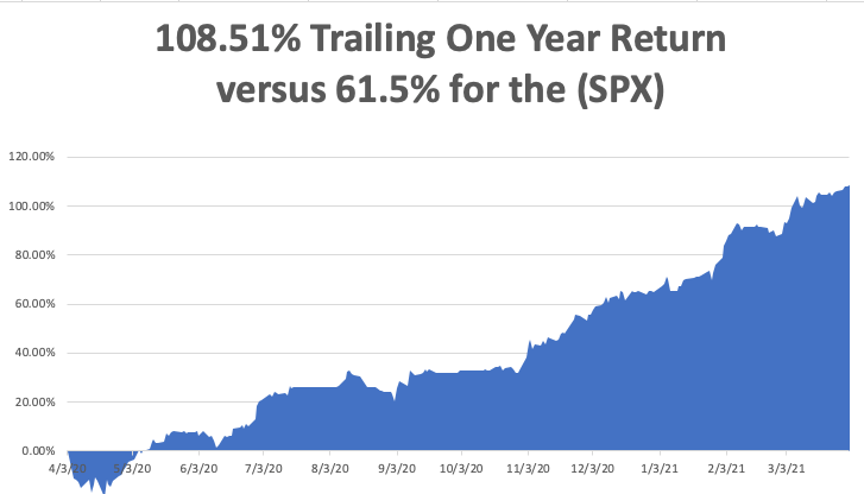
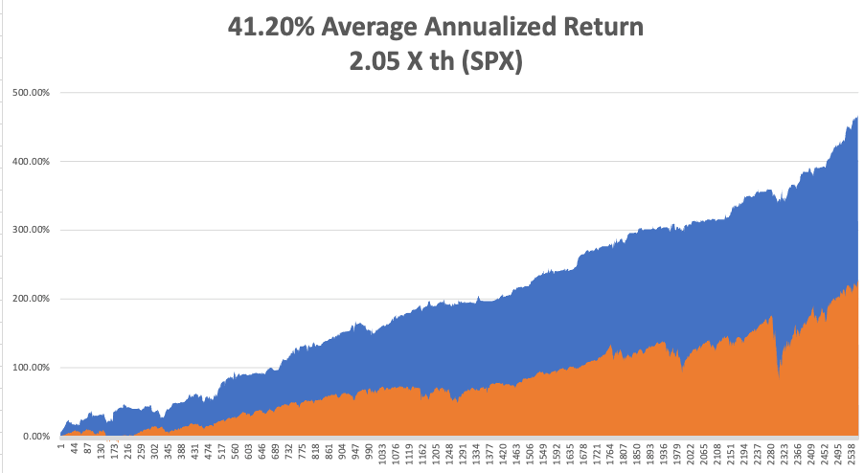

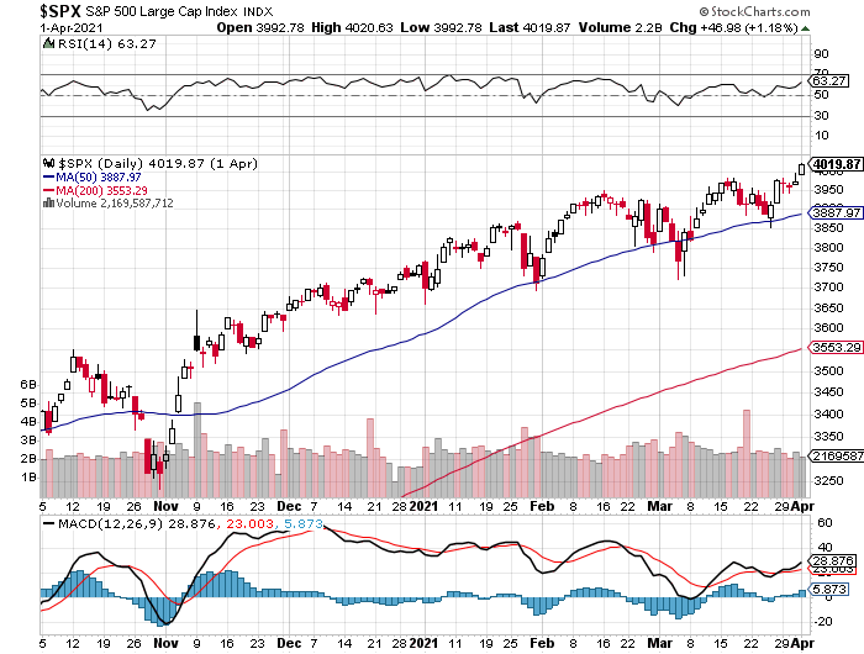
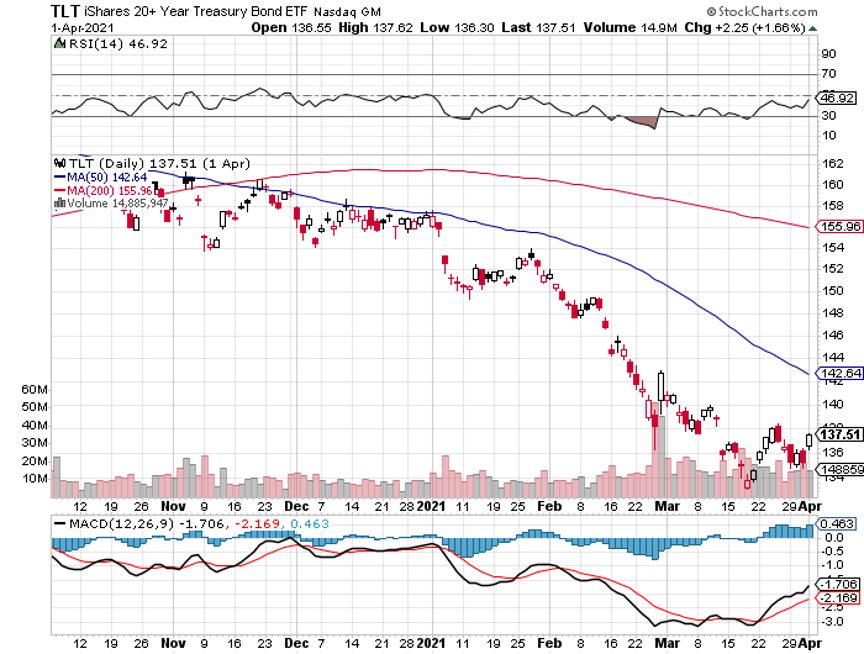
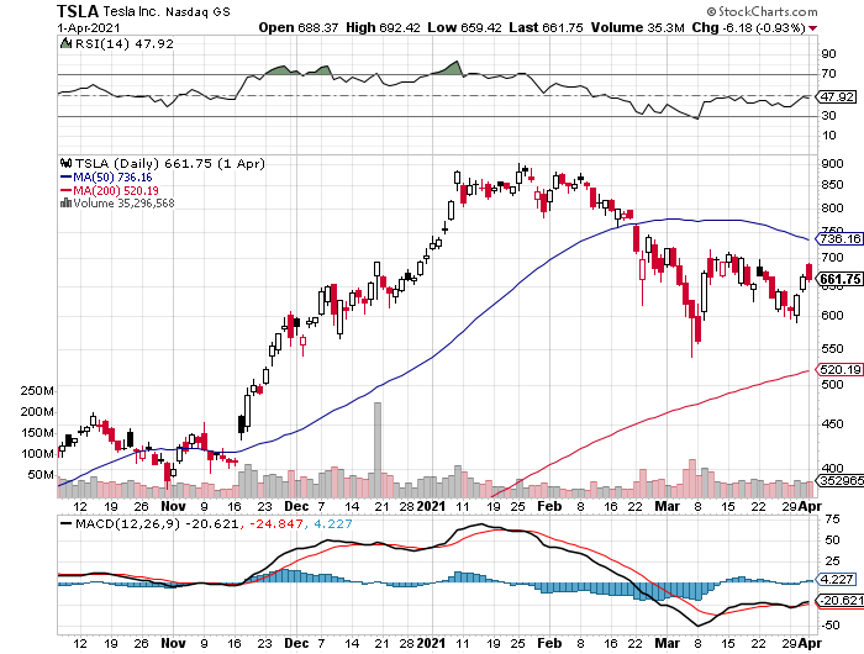
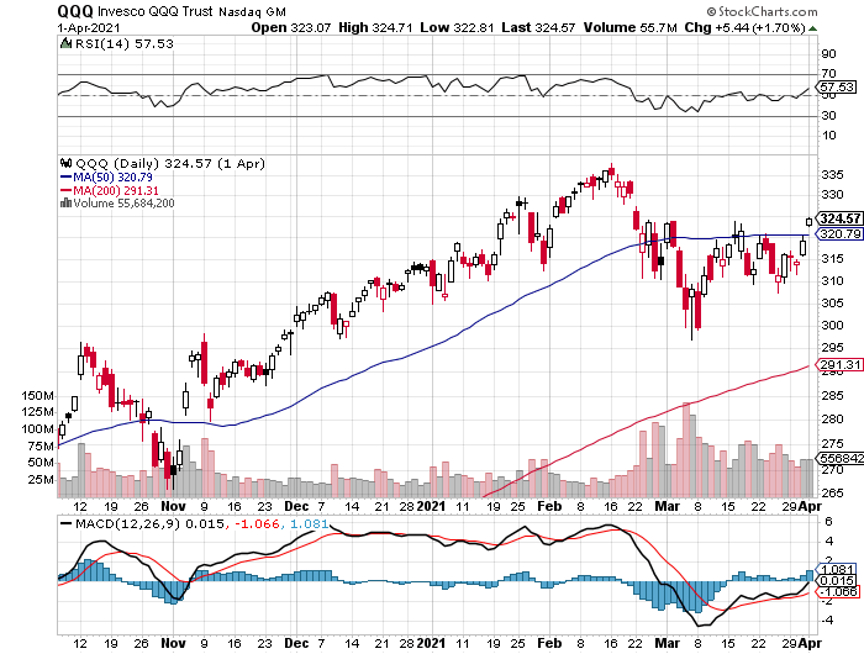
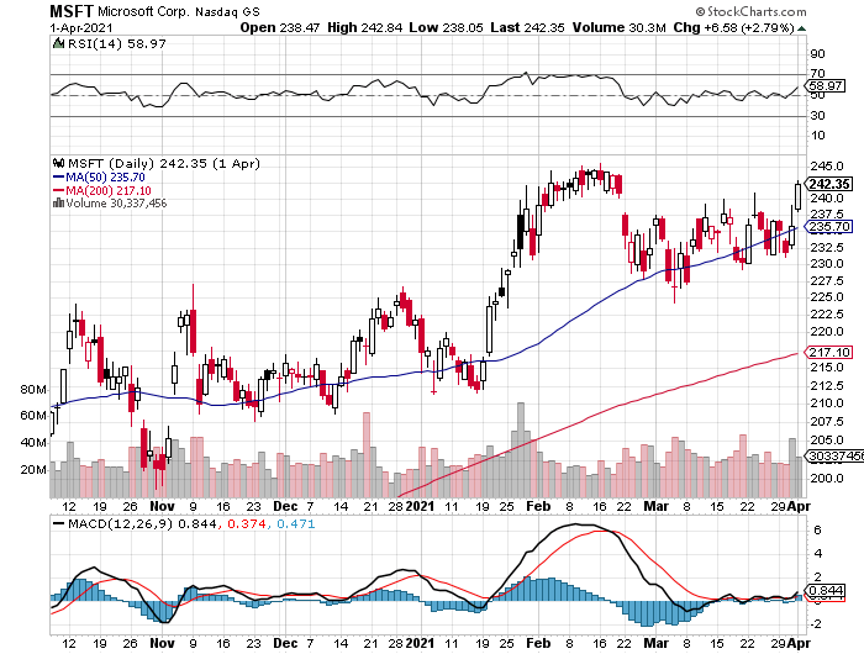
Global Market Comments
November 27, 2020
Fiat Lux
FEATURED TRADE:
(NOVEMBER 25 BIWEEKLY STRATEGY WEBINAR Q&A),
(TSLA), (CRM), (CRSP), (CVS), (SQ), (CRSP), (LUV), (GLD). (SLV), (SPY), (TMO), (UUP), (TAN), (FXA), (FXE), (FXY), (FXB), (CYB)

Below please find subscribers’ Q&A for the November 25 Mad Hedge Fund Trader Global Strategy Webinar broadcast from Silicon Valley, CA with my guest and co-host Bill Davis.
Q: Is gold (GLD) still a hold?
A: Long term yes; short term no. Short term, cash is being drained out of gold in order to buy Bitcoin, just like silver. And once Bitcoin peaks, which could be today or tomorrow when it hits 20,000, then you could get a round of profit-taking and a nice little pop in gold. So, it's basically moving totally counter-cyclically to Bitcoin and the other cryptocurrencies right now.
(Note: since this webinar, Bitcoin has crashed by $3,000)
Q: A competitor of yours claims that asymptomatic transmission of COVID does not occur.
A: I would bet money that person does not have a medical degree. Asymptomatic transmission occurs in almost all diseases, so why COVID would be an exception is beyond me. I suggest that somebody is trying to sell newsletters at your expense with zero knowledge about the topic. Ask him to kiss a Covid victim. This is common in my industry where 99% of the people are crooks. This is also an example of the vast amounts of information that have been spread during an election year.
Q: Will you take a vaccine when it’s out or will you let others try it first?
A: Actually, by the time the public gets the vaccine, more than a million people will have already tried it, so I think it will be fairly safe. I am probably already the most vaccinated person on the planet; I've had flu shots every year for 40 years, so I will happily try it out. At my age, I have little to lose. And I would like to travel again, and that’s going to be a requirement for international travel. I am worried there could be long term side effects that we’ve seen with other drugs in the past, like all future children being born without arms and legs, which is what happened in the 1950s with Thalidomide.
Q: If the Senate flips to the Democrats, how do you see it affecting the market?
A: It doesn’t really affect the market overall; what it will do is affect sector reallocation. Solar, alternative energy and ESG companies do a lot better in A Democratic Senate, and energy oil companies do a lot worse. All you do is short the losers and buy the winners; it really makes no difference who wins. Most of the big conflicts over issues these days are social ones that don’t affect the market.
Q: Where do you see Tesla (TSLA) by the end of the year?
A: Well, this morning, it’s at an all-time high of $565. It looks like it wants to take a run at $600, and then we will be up 50% from where the news was announced that it was joining the S&P 500. That seems to me like a heck of a move on no real fundamental news. During this news, the market completely ignores a Model X recall and a Model Y pan from Consumer Reports. I would be inclined to take profits there or at least roll the strikes up on my options positions.
Q: What’s a good stock to play a commodity recovery?
A: You can’t do any better than Freeport-McMoRan (FCX), which I’ve been following for almost 50 years since I covered it for the Australian Financial Review newspapers.
Q: Will Salesforce (CRM) hold?
A: Yes, it’s just a matter of time before we break out to substantial new highs, and this is a stock that could double next year.
Q: What brokers do you suggest?
A: I would pick tastytrade, owned by my friend Tom Sosnoff who will be speaking at the Mad Hedge Traders & Investors Summit next week and will be answering all your questions. Click here for their site. To register for the summit, click here.
Q: Is CVS (CVS) a good buy?
A: I would say yes; a billion Covid-19 vaccine doses will need to be distributed next year. You can't do that without all the drug companies participating big time.
Q: Does Trump have a chance to win in his lawsuits?
A: It’s more likely that I will be elected the next Miss America; so, I wouldn’t place any bets on that. Some 30 consecutive Republican judges ruling against him does not augur well for his future.
Q: Would you buy any LEAPS here (Long Term Equity Participation Securities)?
A: Only in special one-off situations in the domestic stocks that haven’t moved in ten years. There are a lot of those out there now that I have been recommending. Those are all fertile territory for LEAPs, especially going out 2 years where you get the maximum bang for the buck and a 1,000% return. Don’t touch LEAPs in technology stocks here, and don’t touch Tesla in LEAPs.
Q: What’s your outlook on Southwest Air (LUV)?
A: I like it; it’s one of the healthiest domestic airlines most likely to come back.
Q: Are you going to update your long-term portfolio?
A: Yes, but I only update it twice a year and my next turn is on January 22. If you bought the last update on July 22, you made a fortune getting into Freeport McMoRan at $12 (it’s now $23), CRISPER Therapeutics at $80 (CRSP) (it’s now $110), and Square (SQ) at $110 (the current is $212). You can find it by logging into www.madhedgefundtrader.com, going to My Account, clicking on Global Trading Dispatch, on the drop-down menu, click on the Long-Term Portfolio tab and then clicking on the red tab for the Long-Term Portfolio. That lets you download an excel spreadsheet.
Q: Do you have any LEAPS to suggest now?
A: I only put out portfolios of LEAPS at giant market bottoms like we had in March. Then I put out lists and lists of LEAPS. At all-time highs, it’s not good LEAPS territory, except for specific names. So, if you want to get involved in that on a regular basis, I suggest you sign up for our Mad Hedge Concierge Service. There they are making millions of dollars a week right now.
Q: Where does the US dollar (UUP) go from here?
A: Straight down; the outlook for the buck couldn't be worse. I would be selling short the US dollar like crazy right now except that there are much better trades in US equities.
Q: Just to be clear, there’s no voter fraud?
A: There’s probably never been an election in US history without voter fraud on all sides; it’s just a question of who’s better at it. In the 1948 Texas Democratic Party runoff, back when the party owned Texas, Lyndon Johnson won by 87 votes out of 988,295 cast. It was later found that in five Hispanic-dominated counties that bordered Mexico, everyone had voted 100% for Johnson ….in alphabetical order. Johnson then took the seat with a 66% margin and went on to dominate the US Senate. I remember in the 1960 election, all the military absentee votes were sent flying around in circles over the Atlantic so Kennedy would win; that’s a story that’s been out there for a long time.
Q: You said stay away from other EVs except for Tesla?
A: A few have gone crazy this week, but that doesn’t mean they can actually make a car. So, you might get lucky on a quick trade on some of these, but long term, I don’t think any of the other non-Tesla EV companies are going to make it except for General Motors, which is plowing $27 billion into the sector. Even if (GM) may be able to put out a lot of cars, but they won’t be able to make very much money at it because they’re nowhere near the neighborhood of Tesla with the software where all the money is made.
Q: As the dollar gets weaker, will you expand your international stock picks?
A: Yes, we put out the first one in a long time, Ali Baba (BABA), on Monday, and we’ll be adding to that a bunch. I think the dollar could be weak for 5 or 10 years, a lot like it was in the 1970s.
Q: What’s your outlook for silver (SLV)?
A: Same as for gold (GLD). Quiet for the short term, double for the long term.
Q: Favorite names in biotech?
A: For that, you really need to subscribe to the biotech letter; we’re giving you two names a week there and all of them have done great. But another one might be Thermo Fisher (TMO), which seems to double every time I recommend it. It’s a great takeover target too.
Q: Is there any possibility of a 30% dip in the market (SPY) in 2021?
A: No, I don’t see more than a 10% dip in 2021. The tailwinds now are gale-force, generational, and will run for a decade.
Q: How do you sell the US dollar rally?
A: You buy all the ETFs that we cover in our foreign exchange sections. Those are the Australian dollar (FXA), the Euro (FXE), the Japanese Yen (FXY), the British pound (FXB), and the Chinese Yuan (CYB). Those are five ETFs that will do well on a weak dollar for the next several years.
Q: What about the Invesco Solar ETF TAN?
A: We have been recommending (TAN) for many years and it has done spectacularly well. I still love it long term, but it’s had one heck of a run; it’s up 300% from the March low. I think the entire country is about to have a solar explosion because the costs are now quite simply less than for oil. It’s an economic question. We are going to an all-Electric America.
Q: What do you think about LEAPS on gold?
A: It’s not really LEAPs territory yet, but on a two-year view, you’d have to do well on gold LEAPs.
Q: Is the Invesco DB US Dollar Index Bullish Fund (UUP) good to buy?
A: You should be looking to short the UUP. It’s a long dollar basket which we think will do terribly.
Good Luck and Stay Healthy.
John Thomas
CEO & Publisher
The Diary of a Mad Hedge Fund Trader
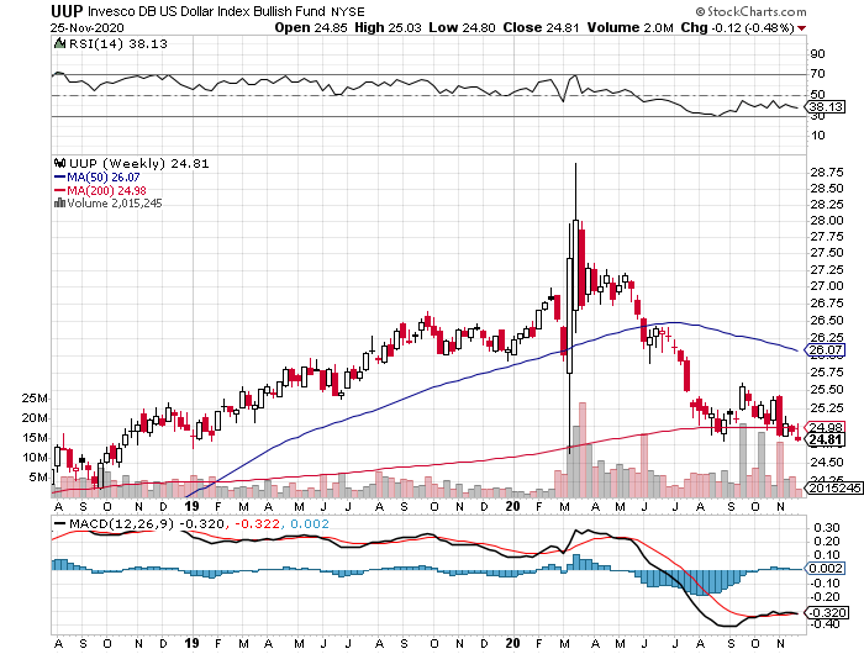
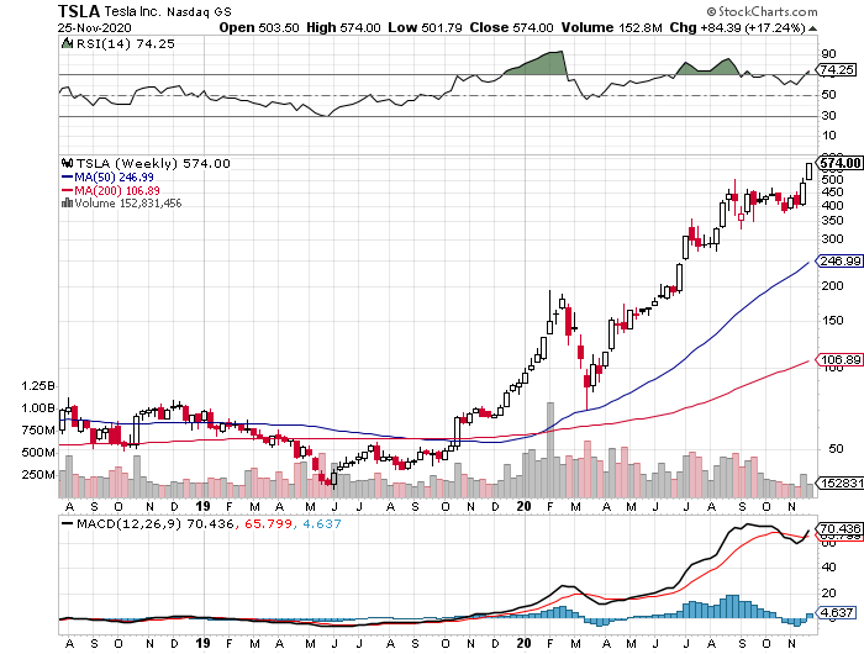
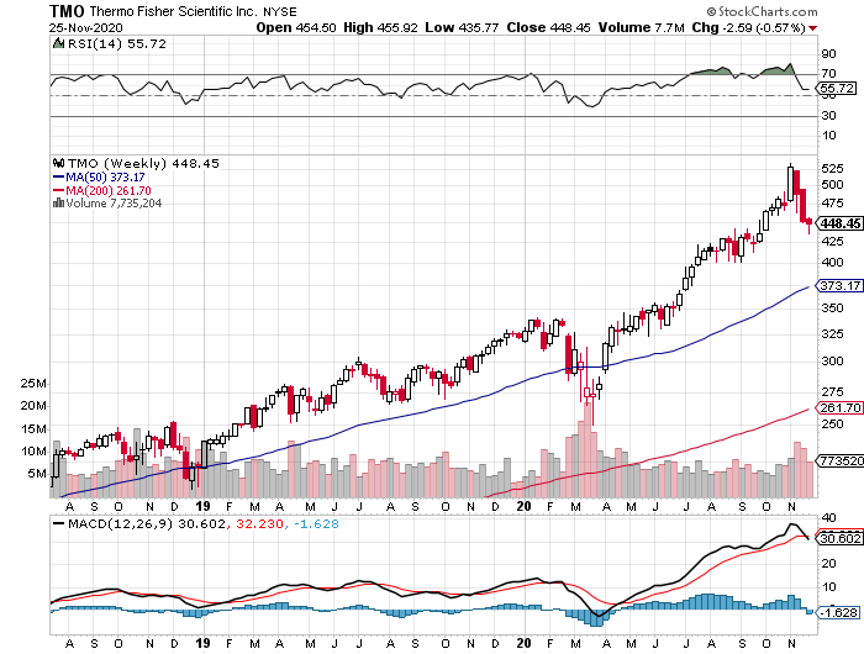
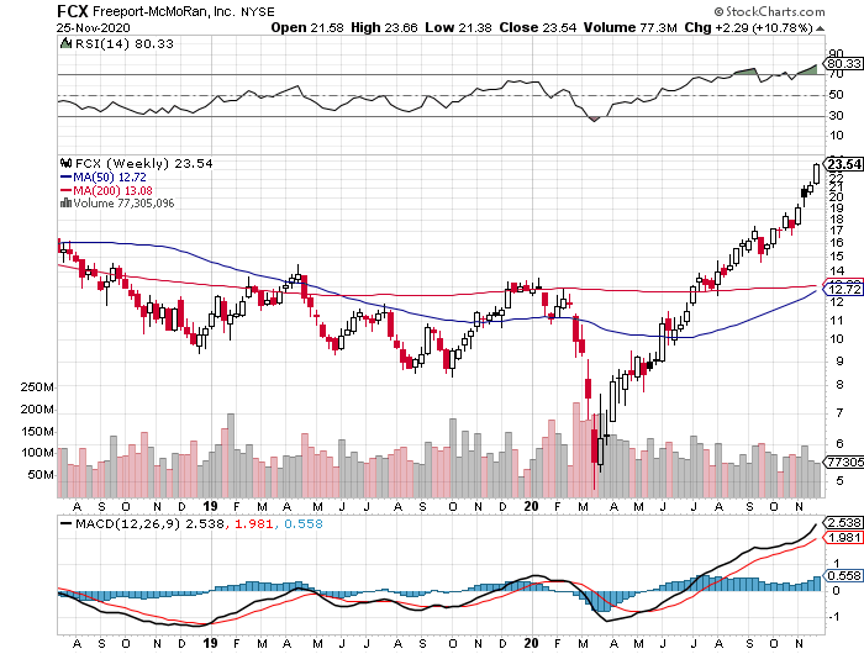
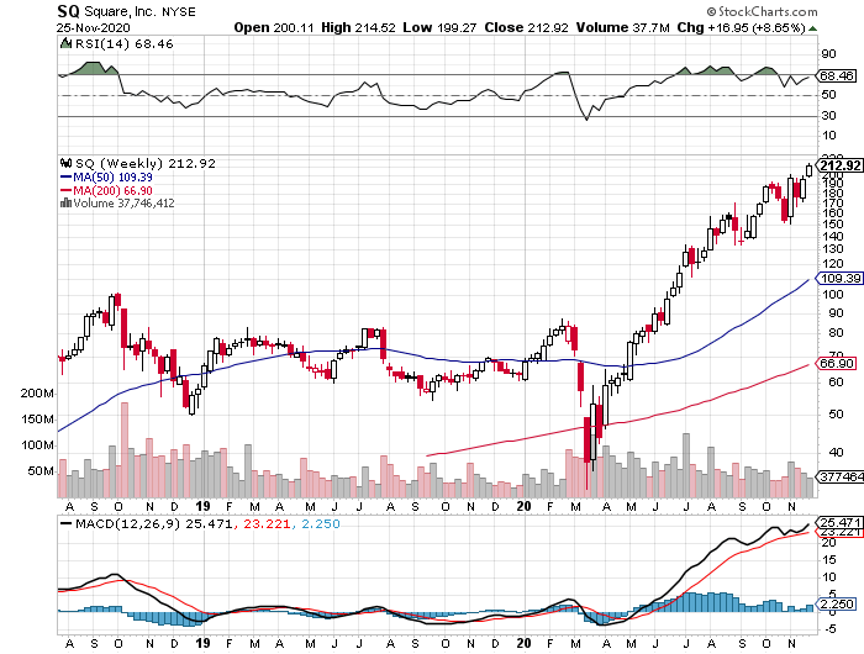

Global Market Comments
May 11, 2020
Fiat Lux
Featured Trade:
(MARKET OUTLOOK FOR THE WEEK AHEAD, or THE NEXT GOLDEN AGE HAS ALREADY STARTED)
(TLT), (TBT), (SPY), (INDU), (VIX),
(DAL), (BRK/A), (LUV), (AA), (UAL)

I always get my best ideas when hiking up a steep mountain carrying a heavy backpack.
Yesterday, I was just passing through the 9,000-foot level on the Tahoe Rim Trail when suddenly, the fog lifted and the skies cleared. I was hit with an epiphany.
It was my “AHA” moment.
The next American Golden Age, the next Roaring Twenties, started on March 23.
However, you have to dive deep into investor psychology to reach that astonishing conclusion.
The conundrum of the day is why stocks are trading at a plus 30X multiple two months into a Great Depression. The economic data has been so horrific that the mainstream news has been reporting them.
Some 30 million unemployed on the way to 51 million? Those are Fed numbers, not mine (click here for the link ). Over 52% of small businesses going bankrupt in the next six months? A GDP that is shrinking at an amazing -40% annualized rate?
Yet, we have a Dow Average that has risen a breathtaking 38% in six weeks. The market has essentially dropped 38% and risen 38% over three months, with the Volatility Index (VIX) making a brief visit to the $80 handle.
To understand these massive contradictions, you have to understand what investors think they are buying. They are not hoovering up stocks that are cheap, offer value, or at the bottom of an economic cycle.
Instead, they are investing in a hope, a vision, an expectation that the coming decade will bring a major economic boom. Yes, they are buying my coming American Golden Age.
Only 10% of the value of a stock is reflected in current year earnings, according to Dr. Jeremy Siegal at the Wharton School of Economics (click here to go to the site). The other 90% is in the following nine years. Investors have written off this year’s earnings and are paying up for the following nine.
Long term followers of this newsletter are well aware of my approaching forecast of the next Roaring Twenties (click here for the link).
Except that this time we have a catapult, the pump-priming effects of the pandemic. The government has stepped in with $14 trillion worth of fiscal and monetary stimulus. Creative destruction is taking place at an exponential rate. Companies have to become hyper-efficient overnight or die.
It’s not rocket science. More than 85 million millennials are aging into their peak spending years, buying homes, cars, and all the luxuries of life. Every time this has happened for the past century, US economic growth leaped to 4%.
It happened in the 1920s, the 1960s, the 1990s, and is about to take place in the 2020s. And with each pop in growth, the stock market rises about 400%. Look at your long-term charts and you’ll see I’m dead right.
That takes us from the March 23 Dow Average low at 18,000 up to 72,000 by 2030, except that it’s a low number. Throw in the hyper-acceleration of innovation by the technology and biotech sectors, a Dow 120,000 is within reach.
You may recall that number from my marketing pitches, except that this time it’s happening. In a decade you are going to look like an absolute genius by following the recommendation of the Mad Hedge Fund Trader.
It also means that we may not see market corrections of any more than 10% this year. That would take us down to a Dow Average of 22,500, and an (SPX) of 2,600 in the coming months. That’s where you should jump in and buy with both hands. The only way I would be wrong is if the US epidemic explodes to unimaginable levels, which is not impossible.
Last week, U-6 unemployment rates exploding to a stratospheric 22.8%. The rate was far higher among high school graduates, but only 8% for college grads. Some 20.2 million lost jobs, ten times the previous record, and more than seen during the Great Depression. The BLS (click here) said the true figure was probably 5% higher due to counting anomalies and a huge backlog of data. And this is just the beginning. The good news is that next month, only 10 million jobs will be lost.
NASDAQ (QQQ) turned positive for 2020, and the followers who piled into tech LEAPS at the March bottom are eternally grateful. Tech and biotech are the only places to be. Everywhere else is a waste of time and money. The entire country is turning into a tech economy or going out of business. Buy tech on dips.
Warren Buffet sold all his airline shares, taking a major loss, including Delta (DAL), Southwest (LUV), American (AA) and United (UAL). The Fed’s $50 billion airline bailout blocked him from making a real killing. His Berkshire Hathaway (BRK/A) (click here) owned close to 10% of all of them. The complete collapse of tourism and business travel are the issues. He sees no recovery in the foreseeable future. They don’t call him the “Oracle of Omaha” for nothing.
US Auto Sales are down a mind-blowing -48% in April, the worst on record. Only 8.6 million cars were sold in the US against last year’s annual rate of 17 million. Toyota and Honda saw the biggest falls as their ships can’t unload due to lack of storage space.
The US Treasury will borrow $3 Trillion this Quarter to fund the massive bailout programs. Announced programs amount to 20 times the $789 billion 2009 rescue package, which Republicans opposed. I’m increasing my bond shorts. Sell short (TLT) again, even if we don’t get a decent rally. Oh, and Trump is threatening a default too. He doesn’t see the connection.
Bonds crashed on massive issuance, with the Treasury announcing a record 20-year bond floatation. Yields hit a one-month high. With the (TLT) down $18 from its recent high, I am taking profits on my bond shorts. I’ll be selling the next rally….again. This could be my core trade for the next decade.
Consumer Debt soared to $14.3 trillion in Q1, a new all-time high. A lot of people are living on their credit cards right now.
Trump threatens to cancel China trade deal, blaming them for Covid-19, sending stocks into a 400-point dive. The last time he did this, shares plunged 20%. It’s all part of an effort to divert attention from the administration’s disastrous handling of the pandemic. America’s Corona deaths are now 20 times China’s, and they are still an emerging nation. Just what we needed, a renewed trade war on top of a pandemic-caused Great Depression, as if the market needed more uncertainty. Sell rallies in the (SPY)
When we come out on the other side of this, we will be perfectly poised to launch into my new American Golden Age, or the next Roaring Twenties. With interest rates at zero, oil at $0 a barrel, and many stocks down by three quarters, there will be no reason not to. The Dow Average will rise by 400% or more in the coming decade.
My Global Trading Dispatch performance had one of the best weeks in years again, up a gob-smacking +6.46%. We are now only 0.65% short of a new all-time high.
My aggressive short bond positions came in big time on the back of theannounced $3 trillion in new debt issuance in Q2. Short bonds are far and away the better quality trade of buying stocks at these elevated levels.
May is up +6.46%, taking my 2020 YTD return up to 2.59%. That compares to a loss for the Dow Average of -13.43% from the February top. My trailing one-year return exploded to 43.77%. My ten-year average annualized profit returned to +34.14%.
This week, Q1 earnings reports continue, and so far, they are coming in much worse than the most dire forecasts. We also get the monthly payroll data, which should be heart-stopping to say the list.
The only numbers that count for the market are the number of US Coronavirus cases and deaths, which you can find here.
On Monday, May 11 at 10:00 AM, the April US Inflation Expectations are out. Caesar’s Entertainment (CZR) and Marriot International (MAR) report earnings.
On Tuesday, May 12 at 5:00 PM, the NFIB Small Business Optimism Index for April is released. Toyota Motors (TM) reports earnings.
On Wednesday, May 13 at 9:30 AM, the ever fascinating weekly Cushing Crude Oil Stocks is announced. Cisco Systems (CSCO) reports earnings.
On Thursday, May 14 at 8:30 AM, we get another blockbuster Weekly Jobless Claims. Advanced Micro Devices (AMD) reports earnings.
On Friday, May 15 at 7:30, AM the Empire State Manufacturing Index is published. The Baker Hughes Rig Count follows at 2:00 PM.
As for me, I’ll continue my solo circumlocution of the 160 mile Tahoe Rim Trail every afternoon in ten-mile segments. Why solo? Do you know anyone else who wants to hike 160 miles at 10,000 feet in two weeks?
Stay healthy.
John Thomas
CEO & Publisher
The Diary of a Mad Hedge Fund Trader
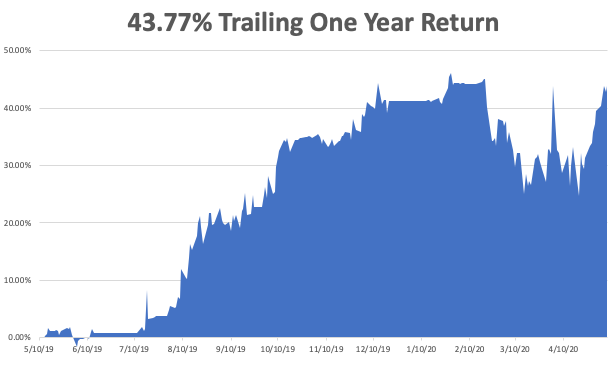
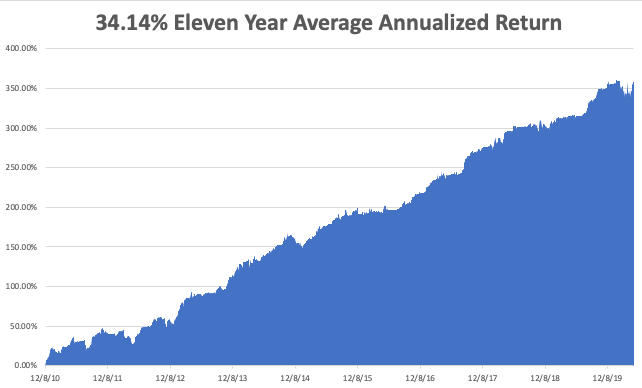
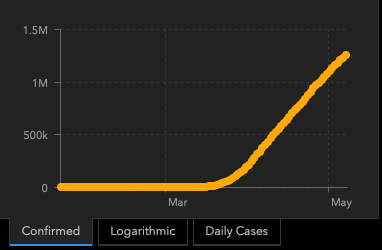
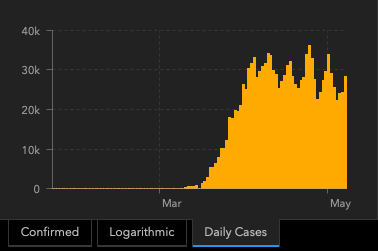
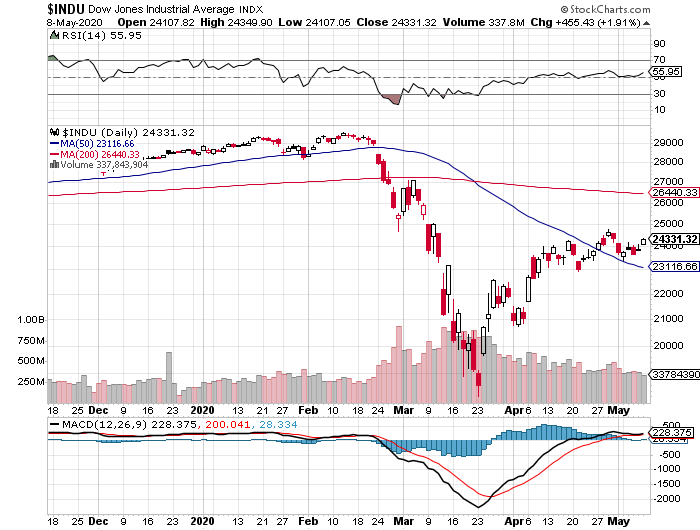
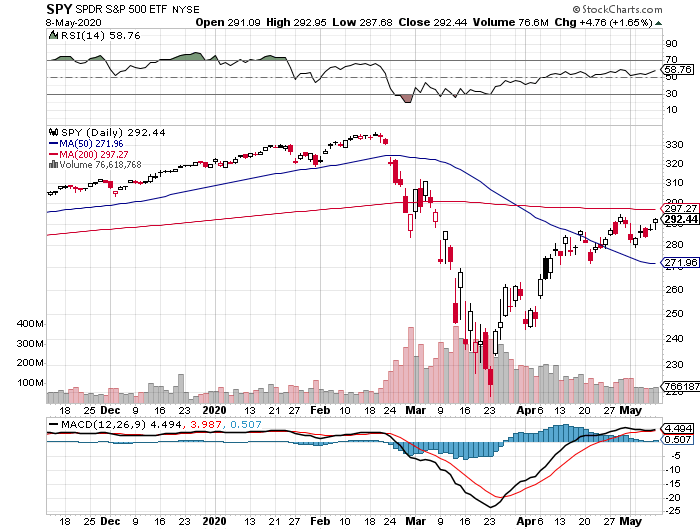
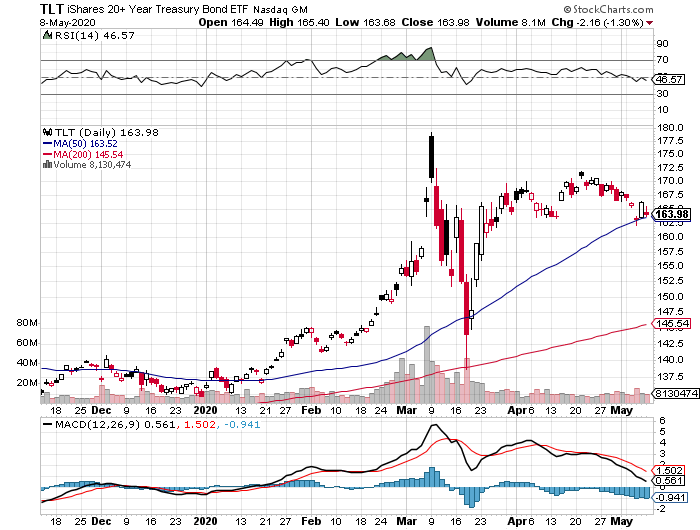
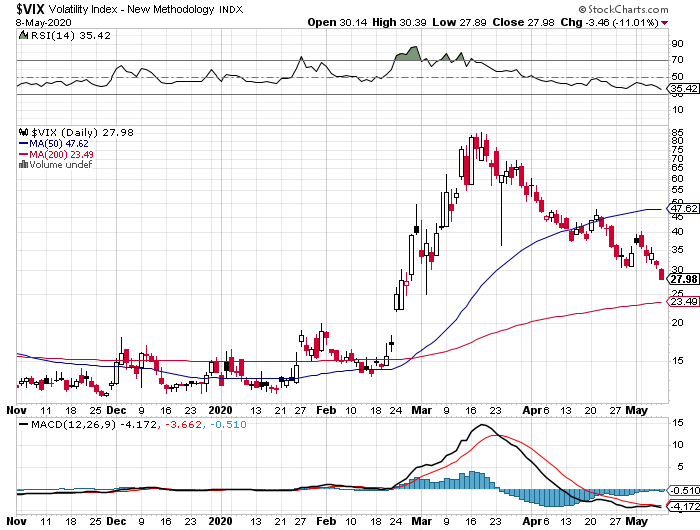

Global Market Comments
April 8, 2019
Fiat Lux
Featured Trade:
(MARKET OUTLOOK FOR THE WEEK AHEAD, OR THE FLIP-FLOPPING MARKET),
(SPY), (TLT), (TSLA), (BA), (LUV), (DAL)
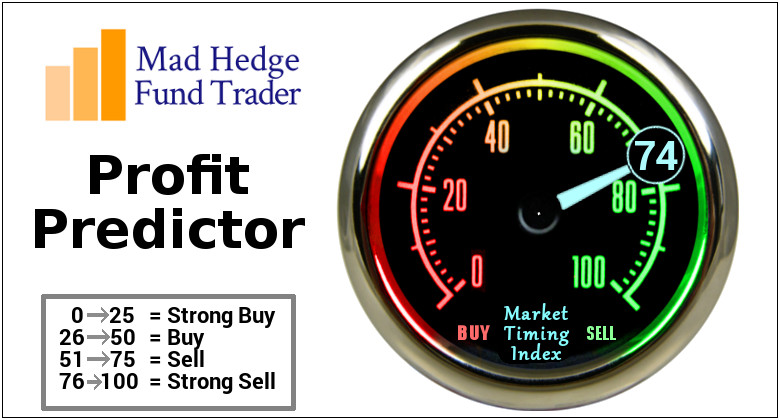
Easy come easy go.
Flip flop, flip flop.
Up until March 25, the bond market was discounting a 2019 recession. Bonds soared and stocks ground sideways. Exactly on that day, it pushed that recession out a year to 2020.
For that was the day that bond prices hit a multiyear peak and ten-year US Treasury yields (TLT) plunged all the way to 2.33%. Since then, interest rates have gone straight up, to 2.52% as of today.
There was also another interesting turn of the calendar. Markets now seem to be discounting economic activity a quarter ahead. So, the 20% nosedive we saw in stocks in Q4 anticipated a melting Q1 for the economy, which is thought to come in under 1%.
What happens next? A rebounding stock market in Q2 is expecting an economic bounce back in Q2 and Q3. What follows is anyone’s guess. Either continuing trade wars drag us back into a global recession and the stock market gives up the $4,500 points it just gained.
Or the wars end and we continue with a slow 2% GDP growth rate and the market grinds up slowly, maybe 5% a year.
Which leads us to the current quandary besieging strategists and economists around the world. Why is the government pressing for large interest rate cuts in the face of a growing economy and joblessness at record lows?
Of course, you have to ask the question of “what does the president know that we don’t.” The only conceivable reason for a sharp cut in interest rates during “the strongest economy in American history” is that the China trade talks are not going as well as advertised.
In fact, they might not be happening at all. Witness the ever-failing deadlines that always seem just beyond grasp. The proposed rate cut might be damage control in advance of failed trade talks that would certainly lead to a stock market crash, the only known measure of the administration view of the economy.
This also explains why politicization of the Fed is moving forward at an unprecedented rate. You can include political hack Stephen Moore who called for interest rate RISES during the entire eight years of the Obama administration but now wants them taken to zero in the face of an exploding national debt. There is also presidential candidate Herman Cain.
Both want the US to return to the gold standard which will almost certainly cause another Great Depression (that’s why we went off it last time, first in 1933 and finally in 1971). The problem with gold is that it’s finite. Economic growth would be tied to the amount of new gold mined every year where supplies have been FALLING for a decade.
The problem with politicization of the Fed is that once the genie is out of the bottle, it is out for good. BOTH parties will use interest rates to manipulate election outcomes in perpetuity. The independence of the Fed will be a thing of the past.
It has suddenly become a binary world. It either is, or it isn’t.
Positive China rumors lifted markets all week. Is this the upside breakout we’ve been looking for? Buy (FXI). While US markets are up 12% so far in 2019, Chinese ones have doubled that.
The Semiconductor Index, far and away the most China-sensitive sector of the market, hit a new all-time high. Advanced Micro Devices (AMD), a Mad Hedge favorite, soared 9% in one day. It’s the future so why not? This is in the face of semiconductor demand and prices that are still collapsing. Buy dips.
Verizon beat the world with its surprise 5G rollout. It’s really all about bragging rights as it is available only in Chicago and Minneapolis and it will take time for 5G phones to get to the store. 5G iPhones are not expected until 2020. Still, I can’t WAIT to download the next Star Wars movie on my phone in only ten seconds.
US auto sales were terrible in Q1, the worst quarter in a decade, and continue to die a horrible death. General Motors (GM) suffered a 7% decline, with Silverado pickups off 16% and Suburban SUVs plunging 25%. Is this a prelude to the Q1 GDP number? Risk is rising. You have to wonder how much electric cars are eating their lunch, which now accounts for 4% of all new US sales.
Tesla (TSLA) disappointed big time, and the stock dove $30. Q1 deliveries came in at only 63,000 as I expected, compared to 90,700 in Q4, down 30.5%. I knew it would be a bad number but got squeezed out of my short the day before for a small loss. That’s show business. It’s all about damping the volatility of profits.
By cutting the electric car subsidy by half from $7,500 in 2019 and to zero in 2020, the administration seems intent on putting Tesla out of business at any cost. I hear the company has installed a revolving door at its Fremont headquarters to facilitate the daily visits by the Justice Department and the SEC. Did I mention that the oil industry sees Tesla as an existential threat?
The March Nonfarm Payroll Report rebounded to a healthy 196,000, just under the 110-month average. Weekly Jobless Claims dropped to New 49-Year Low. Whatever the problems the economy has, it’s not with job creation. But at what cost? Of course, we have to cut interest rates!
Boeing successfully tested new software, even taking the CEO for a ride. Maybe it will work this time. Airlines will love it. (BA) shares have already made back half their $80 losses since the recent crash and we caught the entire move. Buy (BA), (DAL), and (LUV).
The Mad Hedge Fund Trader hit a new all-time high briefly, up 15.46% year to date, and beating the pants off the Dow Average. Good thing I didn’t buy the bearish argument. There’s too much cash floating around the world. However, my downside hedges in Disney and Tesla cost me some money when I stopped out. I was late by a day.
We are taking profits on a six-month peak of 13 positions across the GTD and Tech Letter services and will wait for markets to tell us what to do next.
March turned positive in a final burst, up +1.78%. April is so far down -1.76%. My 2019 year to date return retreated to +13.69%, paring my trailing one-year return back up to +26.59%.
My nine and a half year return recovered to +313.83%, pennies short of a new all-time high. The average annualized return appreciated to +33.62%. I am now 80% in cash and 20% long, and my entire portfolio expires at the April 18 option expiration day in 9 trading days.
The Mad Hedge Technology Letter has gone ballistic, with an aggressive and unhedged 40% long, rising in value almost every day. It is maintaining positions in Microsoft (MSFT), Alphabet (GOOGL), and PayPal (PYPL), and Amazon (AMZN), which are clearly going to new highs.
It’s going to be a dull week on the data front after last week’s fireworks.
On Monday, April 8 at 10:00 AM, February Factory Orders are released.
On Tuesday, April 9, 6:00 AM EST, the March NFIB Small Business Optimism Index is published.
On Wednesday, April 10 at 8:30 AM, we get the March Consumer Price Index.
On Thursday, April 11 at 8:30 AM EST, the Weekly Jobless Claims are announced. The March Producer Price Index is printed at the same time.
On Friday, April 12 at 10:00 AM, the April Consumer Sentiment Index is published.
The Baker-Hughes Rig Count follows at 1:00 PM.
As for me, I have two hours until the next snow storm pounds the High Sierras and closes Donner Pass. So I have to pack up and head back to San Francisco.
But I have to get a haircut first.
Incline Village, Nevada is the only place in the world where you can get a haircut from a 78-year-old retired Marine Master Sargent, Louie’s First Class Barbers. Civilian barbers can never grasp the concept of “high and tight with a shadow”, a cut only combat pilots are entitled to. He’ll regale me with stories of the Old Corps the whole time he is clipping away. I wouldn’t miss it for the world.
Good luck and good trading.
John Thomas
CEO & Publisher
The Diary of a Mad Hedge Fund Trader
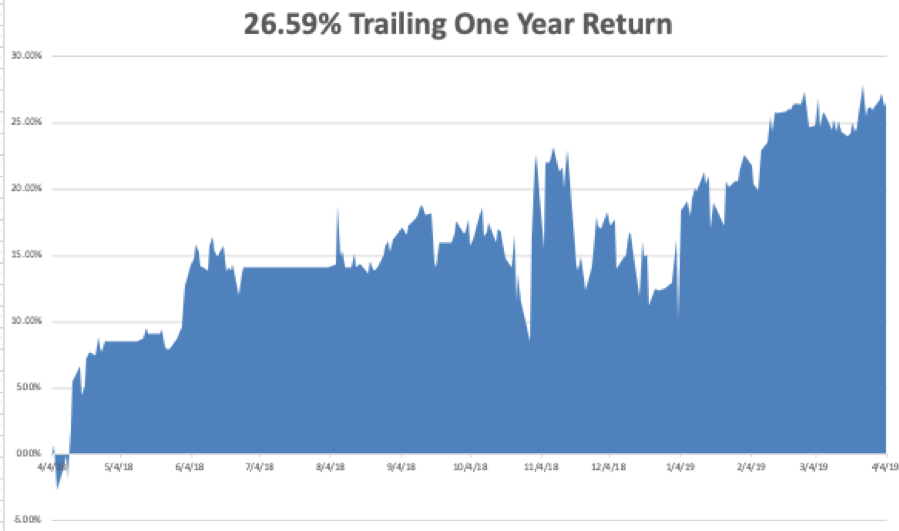

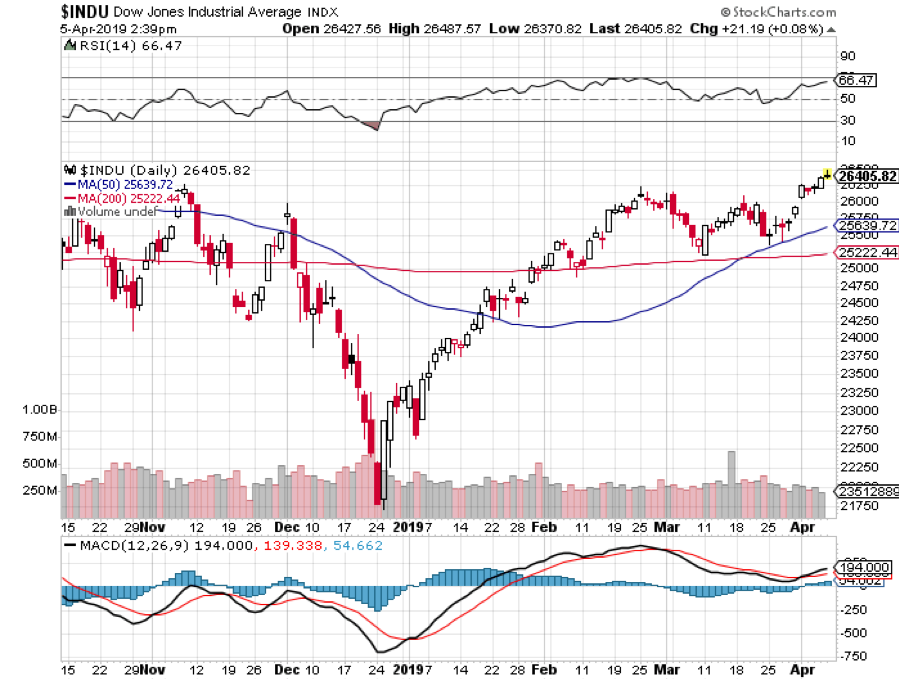
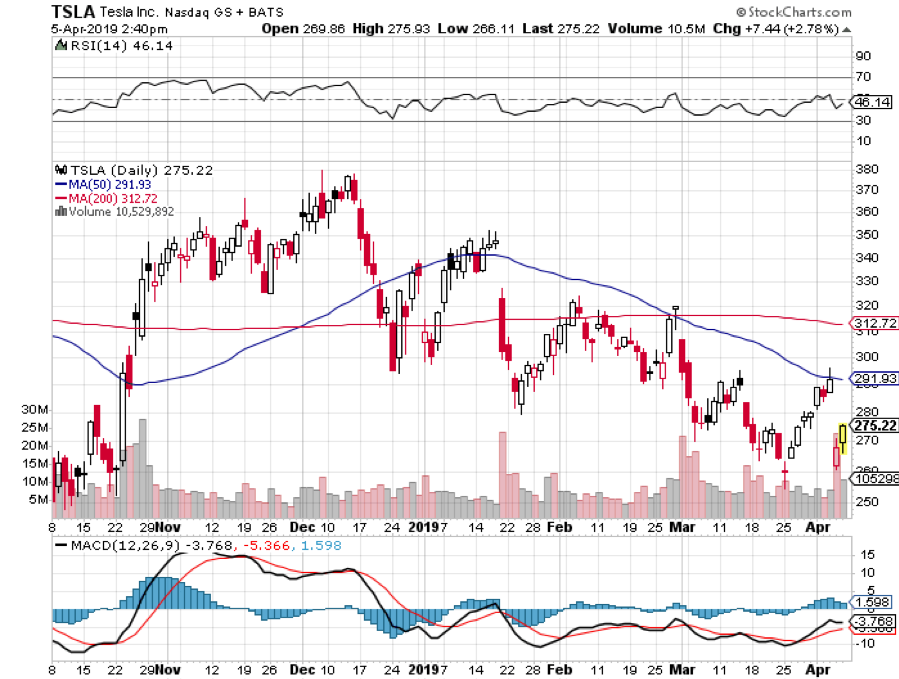
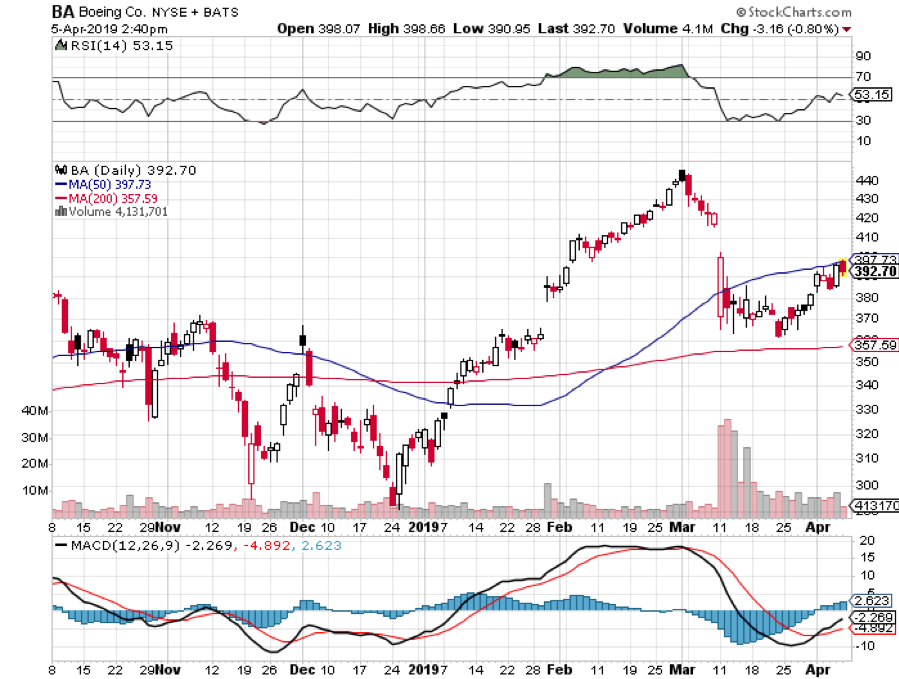
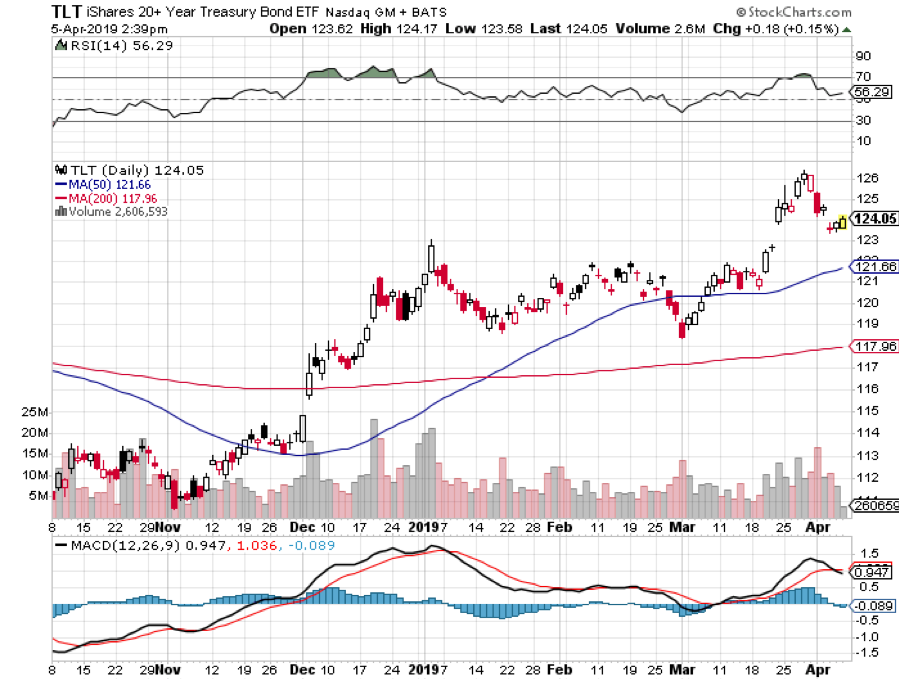

Legal Disclaimer
There is a very high degree of risk involved in trading. Past results are not indicative of future returns. MadHedgeFundTrader.com and all individuals affiliated with this site assume no responsibilities for your trading and investment results. The indicators, strategies, columns, articles and all other features are for educational purposes only and should not be construed as investment advice. Information for futures trading observations are obtained from sources believed to be reliable, but we do not warrant its completeness or accuracy, or warrant any results from the use of the information. Your use of the trading observations is entirely at your own risk and it is your sole responsibility to evaluate the accuracy, completeness and usefulness of the information. You must assess the risk of any trade with your broker and make your own independent decisions regarding any securities mentioned herein. Affiliates of MadHedgeFundTrader.com may have a position or effect transactions in the securities described herein (or options thereon) and/or otherwise employ trading strategies that may be consistent or inconsistent with the provided strategies.
This site uses cookies. By continuing to browse the site, you are agreeing to our use of cookies.
OKLearn moreWe may request cookies to be set on your device. We use cookies to let us know when you visit our websites, how you interact with us, to enrich your user experience, and to customize your relationship with our website.
Click on the different category headings to find out more. You can also change some of your preferences. Note that blocking some types of cookies may impact your experience on our websites and the services we are able to offer.
These cookies are strictly necessary to provide you with services available through our website and to use some of its features.
Because these cookies are strictly necessary to deliver the website, refuseing them will have impact how our site functions. You always can block or delete cookies by changing your browser settings and force blocking all cookies on this website. But this will always prompt you to accept/refuse cookies when revisiting our site.
We fully respect if you want to refuse cookies but to avoid asking you again and again kindly allow us to store a cookie for that. You are free to opt out any time or opt in for other cookies to get a better experience. If you refuse cookies we will remove all set cookies in our domain.
We provide you with a list of stored cookies on your computer in our domain so you can check what we stored. Due to security reasons we are not able to show or modify cookies from other domains. You can check these in your browser security settings.
These cookies collect information that is used either in aggregate form to help us understand how our website is being used or how effective our marketing campaigns are, or to help us customize our website and application for you in order to enhance your experience.
If you do not want that we track your visist to our site you can disable tracking in your browser here:
We also use different external services like Google Webfonts, Google Maps, and external Video providers. Since these providers may collect personal data like your IP address we allow you to block them here. Please be aware that this might heavily reduce the functionality and appearance of our site. Changes will take effect once you reload the page.
Google Webfont Settings:
Google Map Settings:
Vimeo and Youtube video embeds:
